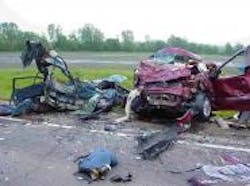“The modern global economy depends on smooth movement of people and goods. But the transportation sector is not without challenges as traffic accidents remain one of the real global killers we face.” –Jonas Hafstrom, Swedish ambassador to the U.S.
No matter how you look at it, the numbers are simply horrific: 1.3 million people killed worldwide every year in traffic accidents, with another 20 million seriously injured. In economic terms, the cost of those fatalities and injuries, combined with property damage and lost worker productivity, is in the neighborhood of about $1 trillion annually, according to research by the World Bank.
Now, about 90% of those 1.3 million traffic fatalities occur in the developing world, even though developing countries are home to only 48% of the globe’s registered vehicles.
And by 2030, according to the World Bank’s projections, some 2.4 million people are going to be dying every year on the globe’s many roadways – making traffic accidents the fifth leading cause of death planet wide.
To address this frightening trend, both within its country’s borders and abroad, Sweden embarked a radical overhaul of its traffic safety philosophy some 13 years ago. Dubbed Vision Zero, it aims to design transport systems that minimize the effects of human driver error.
[Watch as Patrick Magnusson from the Swedish Transport Administration explains some of the key concepts behind the ‘Vision Zero’ philosophy.]
And so far, at least, it seems to be working. Though Sweden is a small country with just 9.3 million people (compared to 307 million in the U.S.), some 5 million motor vehicles ply its roads. Yet Sweden’s traffic deaths have plummeted from the thousands per year to just 358 in 2009 – a number projected to fall even further in 2010, to 280 – and its traffic safety experts credit the nation’s “Vision Zero” philosophy for this achievement.
That gives Sweden a traffic fatality rate of just below 3 per 100,000 people, compared to a rate of 12 traffic fatalities per 100,000 in the U.S.
Look at this another way: the National Highway Traffic Safety Administration (NHTSA) reports that traffic fatalities declined to “a record low” for the U.S. of 33,808 in 2009. That’s the lowest number since 1950, when 33,186 people perished in highway collisions. Yet it also means roughly 92 Americans are killed every day in traffic accidents, meaning we exceed Sweden’s total YEARLY traffic fatalities within just five days.
Yet Patrick Magnusson (seen at left) from the Swedish Transport Administration (who you met in the video clip above) stressed at a traffic safety conference hosted by the Swedish embassy this week in Washington D.C. that many of physical changes wrought by the “Vision Zero” to Sweden’s transportation system my seem strange to American eyes.
For example, take “roundabouts.” These are those infamous traffic circles that replace traditional four-way intersections controlled by stop signs or traffic lights. “These are one of the most important ‘silver bullets’ in Sweden’s traffic system,” Magnusson said.
The weird thing is that MORE accidents occur in roundabouts compared to four-way intersections controlled by traffic lights, he explained; yet they result in FEWER fatalities. That’s because the roundabout slows down traffic speed and, while causing more “fender bender” level accidents, they eliminate those deadly high-speed “T-bone” crashes common when drivers gun the engine to race the traffic light.
Then there are what Sweden calls “shared space” intersections with no traffic lights and no right of way guidance whatsoever. This forces traffic from all sides to slow down so people can figure out how to get through the area – and those slow speeds significantly reduce crash risk.
Finally there is the “2+1” roadway design – boiling a typical four lane road down into one lane travelling in either direction with short “passing areas” built in at regular intervals. The key to this design is a wire “fence” that runs down the center of the roadway, specifically to prevent head-on collisions, said Magnusson.
The “2+1” roads also helps to slow down traffic as speed, he stressed, is the main culprit behind traffic fatalities; the fallout of what he calls “exceeding biomechanical tolerance limits.”
“The problem is that we feel safe driving a car because we don’t ‘feel’ like we’re moving,” he explained. “We become ‘blind’ to the kinetic energy of a moving car in a way.” If drivers just obeyed posted speed limits, Magnusson added, more than 100 extra lives could be saved per year on Sweden’s roadways.
Now, a lot of this may sound controversial to American ears, no doubt – and Magnusson freely admitted that not only are the driving cultures between the U.S. and Sweden very different, but the size and scope of the roadway networks are hugely different, too.
Yet that doesn’t mean many of these concepts can’t be translated successfully to our shores – especially if they help reduce traffic-related deaths and injuries. For that reason, I’ll dig into this topic a little further next week as well.
